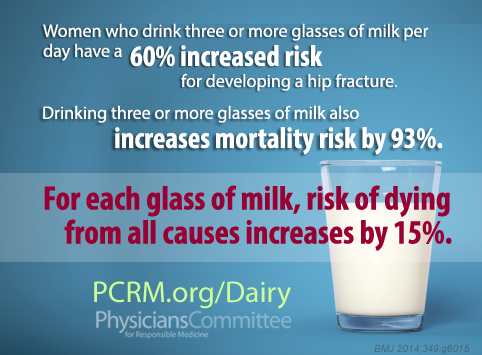More Milk, More Problems

Science Contradicts Milk Marketing
This week, another study has illustrated that milk actually has a negative effect on bone health. Researchers in Sweden published findings in the British Medical Journal showing that women who drink milk have a higher incidence of bone fractures—and an increased risk of mortality from heart disease and cancer.
According to the study, women who consume three or more glasses of milk per day have a 60 percent increased risk of developing a hip fracture and a 93 percent increased risk of death. And each glass of milk increases mortality risk by 15 percent.
However, this news should not come as a shock to anyone outside of the dairy industry’s advertising department. A 2005 review in Pediatrics showed that milk has no effect on preventing stress fractures in girls. In fact, the research linked higher milk consumption with higher fracture risk.
For strong, healthy bones, it’s important to have enough calcium and vitamin D. However, animal products tend to leech calcium from bones, yet plant foods do not have this effect. One cup of collards has 268 mg of calcium. Spinach has 245 mg in a single cup, while a cup of soybeans has 261 mg. When you take fortified orange juice and fortified tofu into account, it’s easy to obtain more than the daily calcium recommendation of 1,000 mg.
Regardless of what milk marketers would have you believe, vitamin D is not naturally occurring in dairy milk. Last week, we examined a recent Canadian study suggesting that children who consumed dairy milk had higher levels of vitamin D. After reviewing the research, we learned that the dairy milk was fortified—while the plant milks were not. Any fortified non-dairy beverage can provide the necessary nutrients, without the cholesterol and saturated fat found in milk.
The science is there: milk does a body bad. Let’s wipe off the milk mustaches and remove milk from the school lunch line. To learn how you can help get milk out of schools, visit www.HealthySchoolLunches.org.







